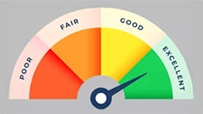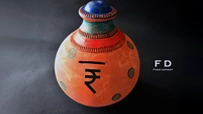How to Manage Fixed Deposits in Rising Interest Rate Environment
September 01, 2025

As interest rates fluctuate, it becomes crucial to have a strategy in place to ensure your Fixed Deposits (FDs) continue to provide the desired returns. One area that requires attention is to manage fixed deposits in rising interest rates environment.
In this article, we will explore FD management tips and strategies on how to manage fixed deposits in a rising interest rate environment. Whether you are a seasoned investor or just starting on your financial journey, these insights will help you make informed decisions and maximise your returns.
FD Management Tips When Interest Rates Are Rising
1. FD Laddering
One effective strategy to manage fixed deposits in rising interest rates environment is implementing the FD laddering strategy. For the unversed, FD laddering involves spreading your investments across multiple FDs with varying tenures and interest rates. By doing so, you can take advantage of rising interest rates and ensure regular cash flow.
Here's how the laddering strategy works:
- Step 1: Divide your total investment amount into smaller portions.
- Step 2: Invest these portions in FDs with different tenure lengths, such as one year, two years, three years, etc.
- Step 3: As each FD matures, reinvest the funds into a new FD with the longest tenure available at the prevailing interest rate.
2. Splitting Investments
Another approach to managing rising interest rates is to split your investment into multiple smaller FDs with different banks or financial institutions. This diversifies your risk and allows you to take advantage of varying interest rates offered by different institutions.
Consider the following example:
Suppose Prashanth has ₹10 lakh to invest in FDs. Instead of depositing the entire amount with a single bank, he splits it into two deposits – ₹5 lakh with Bank A and ₹5 lakh with Bank B. If Bank A offers a higher interest rate than Bank B, he can maximise his returns by investing a larger portion of your funds with Bank.
3. Regularly Monitor Interest Rates
In a rising interest rate environment, it is crucial to stay updated on the prevailing interest rates offered by different financial institutions. By regularly monitoring interest rates, you can identify opportunities to invest in FDs with higher rates, allowing you to maximise your returns.
Financial news websites, bank websites, and dedicated financial apps are excellent sources for staying informed about current interest rates. Moreover, many financial institutions provide personalised notifications to their customers about changes in their FD interest rates.
4. Consider Non-Fixed Income Options
Explore fixed-income securities that offer floating rates, which can increase in value as interest rates rise. These may provide higher returns compared to traditional FDs, especially in a volatile rate environment. These can include instruments like Non Convertible Debentures.
5. Regular review and adjustments
Continuously assess your FD strategy in light of changing market conditions and personal financial goals. This ensures that your investments remain aligned with your objectives and the economic landscape.
Final Thoughts
To manage fixed deposits in rising interest rates environment requires careful planning and strategy. Remember to consider the laddering strategy to take advantage of rising interest rates and the splitting investments approach to diversify your risk. Additionally, regularly monitoring interest rates will enable you to identify opportunities for higher returns.
Looking to grow your savings? Ujjivan SFB offers a wide range of fixed deposit products. Select the FD of your choice and take a step forward to your financial goals. Alternatively, you can browse through Ujjivan SFB product suite - our wide range of financial products are designed to make your financial life better.
Disclaimer:
The contents herein are only for informational purposes and generic in nature. The content does not amount to an offer, invitation or solicitation of any kind to buy or sell, and are not intended to create any legal rights or obligations. This information is subject to updation, completion, amendment and verification without notice. The contents herein are also subject to other product-specific terms and conditions, as well as any applicable third-party terms and conditions, for which Ujjivan Small Finance Bank assumes no responsibility or liability.
Nothing contained herein is intended to constitute financial, investment, legal, tax, or any other professional advice or opinion. Please obtain professional advice before making investment or any other decisions. Any investment decisions that may be made by the you shall be at your own sole discretion, independent analysis and evaluation of the risks involved. The use of any information set out in this document is entirely at the user’s own risk. Ujjivan Small Finance Bank Limited makes no representation or warranty, express or implied, as to the accuracy and completeness for any information herein. The Bank disclaims any and all liability for any loss or damage (direct, indirect, consequential, or otherwise) incurred by you due to use of or due to investment, product application decisions made by you on the basis of the contents herein. While the information is prepared in good faith from sources deemed reliable (including public sources), the Bank disclaims any liability with respect to accuracy of information or any error or omission or any loss or damage incurred by anyone in reliance on the contents herein, in any manner whatsoever.
To know more about Ujjivan Small Finance Bank Products Visit:"https://www.ujjivansfb.in"
All intellectual property rights, including copyrights, trademarks, and other proprietary rights, pertaining to the content and materials displayed herein, belong
to Ujjivan Small Finance Bank Limited or its licensors. Unauthorised use or misuse of any intellectual property, or other content displayed herein is strictly prohibited and the same is not intended for distribution to, or use by, any person in any jurisdiction where such distribution or use would (by reason of that person’s nationality, residence or otherwise) be contrary to law or registration or would subject Ujjivan Small Finance Bank Limited or its affiliates to any licensing or registration requirements.
FAQs
1. How often do fixed deposit interest rates change?
Fixed deposit interest rates may vary depending on market conditions and the policies of different financial institutions. It is advisable to regularly monitor these rates for the most accurate information.
2. How can I manage fixed deposits in rising interest rates environment?
Implementing laddering strategy, regular monitoring and comparing FD rates can help you manage manage fixed deposits in rising interest rates environment.
3. What happens if the financial institution offering my fixed deposit goes bankrupt?
Fixed deposits are generally considered safe investments; however, in the unlikely event that the financial institution goes bankrupt, the Deposit Insurance and Credit Guarantee Corporation (DICGC) provides insurance coverage of up to ₹5 lakh per depositor per bank.
4. Can I add funds to an existing fixed deposit?
No, once you open an FD, you cannot add additional funds to it. However, you can open a new FD with additional funds if desired.
5. Can I choose a different tenure or interest rate for my existing FD?
Once you open an FD, the tenure and interest rate are locked in for the entire duration of the deposit. If you wish to change these parameters, you would need to prematurely withdraw your existing FD and open a new one with the desired terms.
6. Is it better to invest in shorter-term or longer-term fixed deposits to manage fixed deposits during rising interest rates?
To manage fixed deposits in rising interest rates regime, investing in shorter-term fixed deposits allows you to take advantage of increasing rates when your deposits mature. However, longer-term deposits may offer higher initial interest rates and provide stability over an extended period.
7. Can I receive regular interest payouts from my fixed deposit?
To receive regular interest payouts, opt for non-cumulative Fixed Deposits. Such FDs offer periodic interest payments - monthly, quarterly and annually.
8. Which bank offers high-interest FDs?
Ujjivan SFB offers high-interest deposits that can help maximise your savings.
9. Should I consider investing in company fixed deposits as well?
Explore fixed deposits from companies with high credit ratings, which may offer competitive interest rates compared to traditional banks.
Latest Blogs

Credit Score Not Improving? 5 Mistakes You Might Be Making
August 13, 2025
For most of us, a credit score feels like a silent judge sitting in the background of our financial lives.

Banking Jargon Decoded: 15 Key Terms You Should Know
May 13, 2025
Banking feels simple on the surface; deposit money, withdraw when needed, pay bills, or transfer funds.

The ₹10 Lakh Rule for Cash Deposit Explained
August 13, 2025
Every day, millions of Indians walk into their banks to deposit cash, sometimes a few thousand rupees, sometimes several lakhs.

Missed Income or Errors? Here’s How ITR-U Can Save You from Penalties
August 13, 2025
Less than three weeks remain before the September 15 deadline to update income tax returns.

This Current Account is Designed to Empower Your Business
June 16, 2025
In the fast-paced world of business, having the right bank account can be a game-changer.





